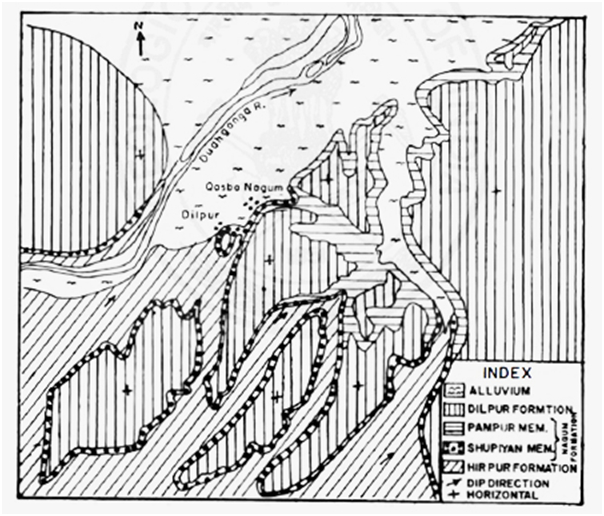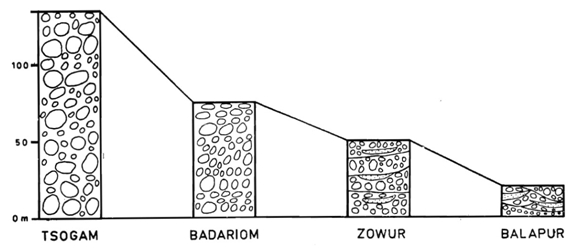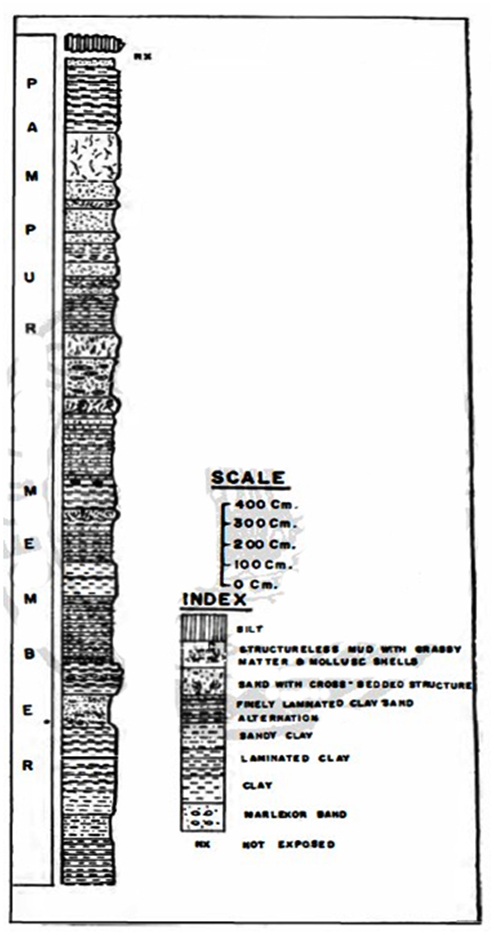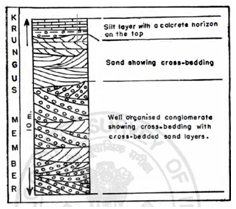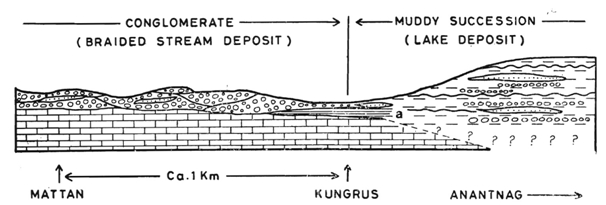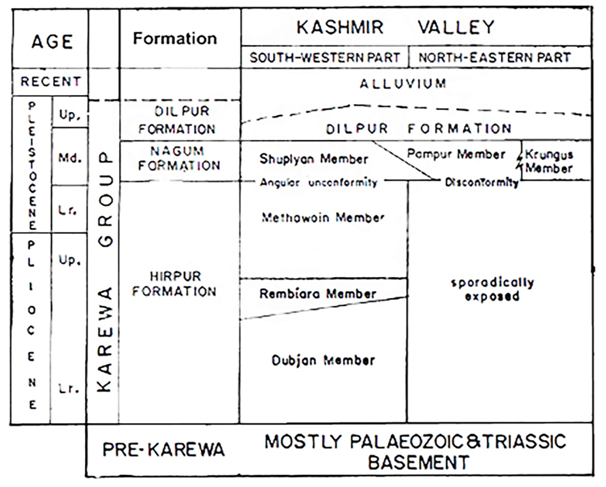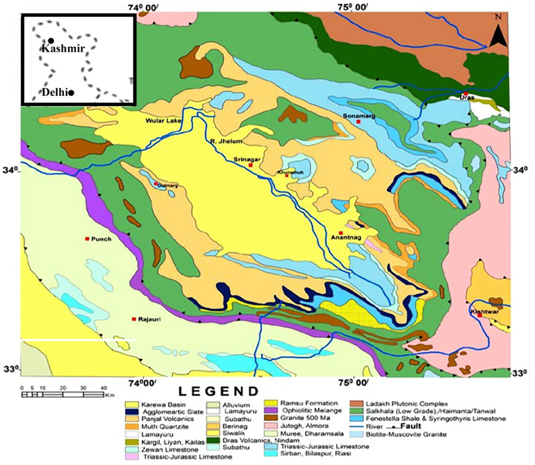Nagum Fm
Type Locality and Naming
Its name is derived from village Qasba Nagum on the Srinagar-Yusmarg highway. Type section is in Qasba Nagum section (Bhatt, 1989). Its thickness in neotype section is 30 m. [Original Publications: Bhatt, D.K. 1989. The lithostratigraphy of Karewa Group, Kashmir Valley, India and a critical review of its fossil record. Memoirs Geological Survey of India, 122: 85p. Wadia, D.N. 1941. Pleistocene Ice Age deposits of Kashmir. Proceedings National Institute of Science, India, 7(1): 49-59]
Type localities of Members: Bhatt (1989) designated Rembiara river left bank section opposite Shupiyan town as type section for Shupiyan Member; Sambur village west side cliff wall section as type section for Pampur Member; and Krungus village section as type section for Krungus Member. These sections can be considered for reference sections of Nagum Formation as its three lithofacies developed individually in different parts of the basin under different depositional environment.
Synonyms: In Wadia’s (1941) scheme of classification, the sequence under the Nagum Formation formed part of his Upper Karewa Stage, whereas Farooqi and Desai (1974) had called it as Shopian Formation.
[Figure 1: Geological map of the type area of Nagum and Dilpur formations (Bhatt, 1989)]
Lithology and Thickness
Conglomerate to Sandy clay. The Nagum Formation consists of gravel, sand, sandy clay, clay and marl. The sand is medium to coarse grained. The sandy clay is brown and grey in color and the marl is cream colored. Litho facies: Gravel sequence of matrix rich conglomerate with large clasts and gravels embedded in sandy matrix; laminated silt sequence of grey – yellow sandy clay, yellow silt, green medium grained sand, bands of carbonates within the silt and mottled mud layers and few conglomerates; cross bedded sand layer and conglomerate, sandy clay with calcrete (Singh, 1982; Bhatt, 1989). Its thickness is about 40-135 m.
Its variations in SW and NE parts have been designated as the Shupiyan, Pampur and Krungus Facies. Bhatt (1989) classified these Facies as the Shupiyan, Pampur and Krungus Members:
Shupiyan Member: It mainly comprises a succession of matrix-rich conglomerates having rare sand-rich lenticular layers. Also present are silty horizons as capping and abundant calcrete levels. The Shupiyan Member shows features of a braided stream deposit. One arm of such braided system met the lake near Dilpur-Nagum, producing a delta complex.
Pampur Member: It has cream/yellowish silty mud, finely laminated rhythmites of silt and clay, green medium to coarse-grained sand layers, cream fine sand - silty sand. Lydekker (1883) and De Terra and Patterson (1939) classified sequence belonging to the Pampur Formation under the “Lower Karewas”.
Krungus Member: This is developed near Krungus Village in the Mattan area as a 5 to 6 m thick conglomerate horizon, laterally traceable over a distance of 3 to 4 km. The conglomerate shows prominent scouring and large-scale cross-bedding. There are also dcm-thick sand lenses showing large-scale cross-bedding. It also shows calcrete horizons. It is considered a deposit of braided streams.
[Figure 2: Variation in thickness of Shupiyan Member. Also matrix rich poorly organized conglomerates change to well organized conglomerates with sand lenses (Singh 1982)]
[Figure 3: Lithocolumn of type sections of Pampur member of Nagum Formation near Sambur village (Bhatt, 1989)]
[Figure 4: Lithocolumn of type sections of Krungus member of Nagum Formation near Krungus village (Bhatt, 1989)]
[Figure 5: Two facies variants of the Nagum Formation along Mattan-Anantnag road section. The braided stream deposits of Krungus Member resting over Triassic Limestone towards Mattan thins out towards Krungus where it is underlain by grey mud of Hirpur Formation (a) and then changes to lake deposits of Pampur Member towards Anantnag (Singh 1982; Bhatt, 1989)]
Relationships and Distribution
Lower contact
Upper contact
Upper contact conformable with overlying Dilpur Fm.
GeoJSON
Fossils
Mammals: Rhinoceros sp., Cervus sp., Bos sp., Sus sp., Elephas hysudricus, Canis vitastensis; De Terra and Patterson (1939) reported Elephus hysudricus and other vertebrate mammal fossils in the basal part of the Pampur Member.
Fish: Schizothorax esocinus, Oreinus sp., Cyprinus carpio communis; molluscs: Gyraulus convexiusculus, Gyraulus sp. cf. G. pankongensis, Gastrocopa (S.S.) kashmirensis, Planorbis Planorbis tangitarensis, Pisidium (Eupisidium) hydaspicola, Pisidium (Eupisidium ?) mitchelli; Ostracods: Darwinula stevensoni, Cyprinotus salinus, Cypris subglobosa, Cypridopsis vidua, Potamocypris minuta patriciae, Candona albicans, C. cf. angulata, C. candida, C. compressa, C. lactea, C. neglecta, C. cf. detecta, Candonopsis sp. cf. kingsleyi, Cypria opthalmica, Illyocypris bradyi, I. kashmirensis, I. shawneetownensis, Limnocythere staplini (Badam 1968, 1972; Bhatia 1968, 1969,1974; Sahni, 1982; Kotlia, 1987, 1989, 1990).
Age
Depositional setting
[Varun Parmar & Rajeev Patnaik version:] The disposition of lithofacies in the Nagum sequence indicates a smaller lacustrine basin during Nagum time then the preceding Hirpur Fm times. The change in areal spread of the lake was consequent to an uplift of the Pir Panjal range that resulted in the uplift of the SW part of Kashmir valley on which the Shupiyan Member was deposited by a braided stream. The reduced lake was restricted to the NW part of Kashmir valley in which Pampur Member was deposited in 1-2 m deep lake. The lake bottom was thus always within the reach of waves and received enough sunlight to support subaqueous vegetation. The rivers meeting the lake basin formed Gilbert type delta. The lake margin lacked swamps. The lack of sand layers and absence of mottling by rootlets suggest the some parts of lakes were deep where facies developed at depths of 5–10 m. In the extreme northeastern peripheral part, the uplift of Saribal range concomitant with the Pir Panjal range led to the deposition of Krungus Member as braided stream deposits. Thus the commencement of the deposition of the three lithological members of Nagum Formation is broadly coeval (Singh, 1982; Bhatt, 1989).
[O.N. Bhargava & Birendra Singh version:] The green medium to coarse-grained sand denotes rapid supply of sand and rapid deposition. The cream-colored fine sand-silty sand indicates deposition of finer sand at moderate rate. The sandy sediments invariably show wave ripple structures. In Sambur village, a sand-rich succession contains numerous vertebrate fossils (De Terra and Patterson, 1939). The Pampur Member was deposited in a 1 to 2 m deep lake; as a result the lake bottom was always within the reach of waves, which received enough sunlight and supported dense subaqueous vegetation. The deeper facies lack sand layers and mottling by rootlets, in a depth between 5 and 10 m. The rivers meeting the lake basin formed Gilbert type delta. In some sections the lacustrine sediments laterally pass into conglomerates of the braided streams. Carbonates were precipitated during slow rate of terrigenous supply and later pedogenesis formed discontinuous calcareous bands.
Additional Information
